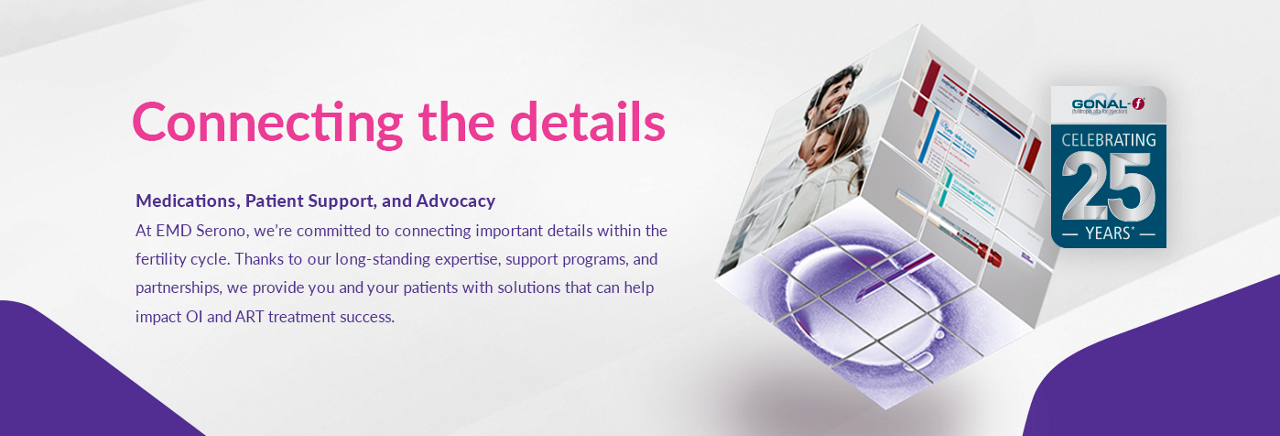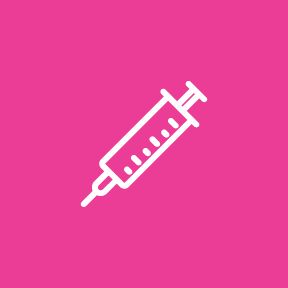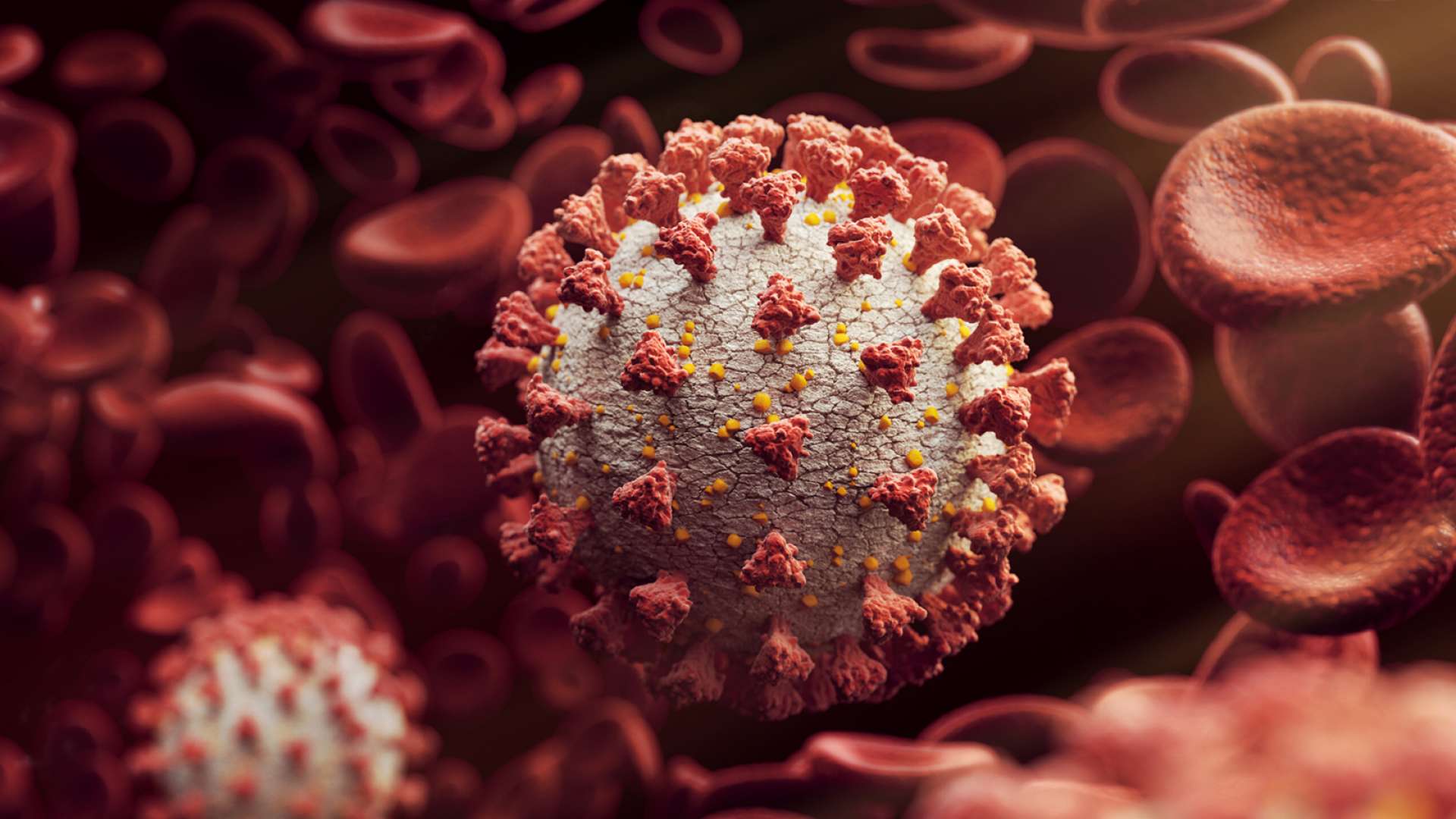Join us in celebrating a shared milestone!
Watch the video to see how GONAL-f® Redi-ject has over 6 million1 success stories and how we remain determined to improving care for patients everywhere
Resuming treatment after COVID-19 interruption
The world may have changed, but our commitment remains. Connect with resources designed to help support patients during the COVID-19 era.
Apply for replacement medication >
A legacy of firsts in fertility
EMD Serono has been here since the very beginning. We’ve been building our treatment portfolio for years, from our first gonadotropins to the many variations since.2,3 Our products were instrumental in the birth of the first IVF baby in the United States,3,4 and we’ve been expanding our treatments ever since, with a fertility portfolio designed to help your patients achieve a pregnancy outcome.
Feedback and insights from patients and fertility experts alike have helped us shape our portfolio and deliver support when and where it’s needed. We’re committed to being there for you as you help patients navigate every step of the OI and ART fertility treatment cycle.
OI = ovulation induction.
ART = assisted reproductive technology.
*The original GONAL-f formulation was approved for use in Europe in 1995.
References
1. Borget I, et al. Gynecol Obstet Invest. 2024;1-15
2. Lunenfeld B. Hum Reprod Update. 2004;10(6):453-467.
3. Practice Committee of the American Society for Reproductive Medicine. Fertil Steril. 2008;90(5 Suppl):S13–S20.
4. Cohen J. Hum Reprod. 2005;11(5):439-460.
IMPORTANT RISK INFORMATION & INDICATIONS AND USAGE
Summary of Contraindications Gonal-f® (follitropin alfa injection) RFF* Redi-ject® and Gonal-f® (follitropin alfa for injection) Multi-Dose are contraindicated in patients with prior hypersensitivity to r-hFSH or excipients, high levels of FSH indicating primary gonadal failure, pregnancy, uncontrolled thyroid, adrenal or pituitary disorders, sex hormone dependent tumors of the reproductive tract/accessory organs, tumors of pituitary gland or hypothalamus, abnormal uterine bleeding of undetermined origin and ovarian cyst or enlargement of undetermined origin. Please scroll for full IMPORTANT RISK INFORMATION for Gonal-f® RFF* Redi-ject®, Gonal-f® Multi-Dose and click here for full Prescribing Information for each individual product. RFF : Revised Formulation Female
Important Risk Information for Gonal-f® Multi-Dose (follitropin alfa for injection) Contraindications: GONAL-f® Multi-Dose is contraindicated in women and men who exhibit:
GONAL-f Multi-Dose is also contraindicated in women who exhibit:
WARNINGS Overstimulation of the Ovary During FSH Therapy: Ovarian Torsion Abnormal Ovarian Enlargement Multi-fetal Gestation and Birth Embryofetal toxicity Ectopic Pregnancy Spontaneous Abortion Ovarian Neoplasms Laboratory Tests In most instances, treatment of women with GONAL-f Multi-Dose will result only in follicular recruitment and development. In the absence of an endogenous LH surge, hCG is given to trigger ovulation when monitoring of the woman indicates that sufficient follicular development has occurred. This may be estimated by ultrasound alone or in combination with measurement of serum estradiol levels. The combination of both ultrasound and serum estradiol measurement are useful for monitoring follicular growth and maturation, timing of the ovulatory trigger, detecting ovarian enlargement and minimizing the risk of the OHSS and multiple gestation. ADVERSE REACTIONS Men - There was one serious adverse reaction of gynecomastia requiring surgical excision of breast tissue in a 50-year-old man who received 9 months of therapy with GONAL-f Multi-Dose. Pathology report showed gynecomastia with no atypia. Adverse reactions reported in ≥ 2 patients were acne, injection site pain, gynecomastia, seborrhea, fatigue and libido decreased. Specific Populations: Pregnancy: GONAL-f Multi-Dose is not indicated in pregnant women. There is no human data that the use of gonadotropins (including GONAL-f Multi-Dose) alone or as part of IVF or ICSI cycles, increases the risk of congenital malformations.
Lactation: There are no data on the presence of GONAL-f Multi-Dose in human milk, the effects on the breastfed infant, or the effects on milk production. Because the secretion of prolactin during lactation can result in inadequate response to ovarian stimulation, advise women not to breast feed during treatment with GONAL-f Multi-Dose.
Females and Males of Reproductive Potential: Because GONAL-f Multi-Dose is not indicated in pregnant women, verify a negative pregnancy test before administering GONAL-f Multi-Dose to a woman
Pediatric Use: Safety and effectiveness in pediatric patients have not been established. Geriatric Use: Safety and effectiveness of GONAL-f Multi-Dose in postmenopausal women have not been established and it is not indicated in this population.
Patient Counseling: Instruct women and men on the correct usage and dosing of GONAL-f Multi-Dose. Caution against changing the dosage or the schedule of administration unless instructed to do so by a healthcare provider. Prior to beginning therapy with GONAL-f Multi-Dose, inform women and men about the time commitment and monitoring procedures necessary for treatment Inform women and men that if they miss or forget to take a dose of GONAL-f Multi-Dose, they should not double the next dose and should call their healthcare provider for further dosing instructions. For more information, please see the full Prescribing Information and Instructions for Use for GONAL-f Multi-Dose Indications and Usage:
|
Important Risk Information for Cetrotide® (cetrorelix acetate for injection) Cetrotide® is contraindicated in women who are pregnant, are nursing, or have severe renal impairment. Cetrotide® is also contraindicated in women who exhibit or have known hypersensitivity to cetrorelix acetate, mannitol, extrinsic peptide hormone, GnRH or any other GnRH analogs. Treatment with Cetrotide® is not advised in women with severe allergic conditions. Cases of hypersensitivity reactions, including anaphylactoid reactions have been reported. Other adverse events reported include ovarian hyperstimulation syndrome, nausea, headache, and local injection site reactions. Multiple births and congenital abnormalities have been reported. Indication
|
Important Risk Information for Ovidrel® PreFilled Syringe (choriogonadotropin alfa injection) Ovidrel® PreFilled Syringe should only be used by physicians who are experienced with infertility problems, their management and appropriate selection and monitoring of patients. Ovidrel® PreFilled Syringe is contraindicated in women who exhibit prior sensitivity to hCG preparations, mannitol, or one of their other excipients, primary ovarian failure, uncontrolled thyroid or adrenal dysfunction, an uncontrolled intracranial lesion, abnormal uterine bleeding of an undetermined origin, an ovarian cyst or enlargement of an undetermined origin. Women who are pregnant or nursing should not use Ovidrel® PreFilled Syringe. Ovidrel® PreFilled Syringe is a potent gonadotropic substance capable of causing Ovarian Hyperstimulation Syndrome (OHSS) and ovarian enlargement with or without pulmonary and vascular complications. Adverse reactions reported include injection site reactions, GI disorders, abdominal pain, nausea, vomiting, ovarian cyst, ovarian hyperstimulation, and thromboembolic events. Multiple births and congenital abnormalities have been reported. Indication
|
IMPORTANT RISK INFORMATION & INDICATIONS AND USAGE
Summary of Contraindications Gonal-f® (follitropin alfa injection) RFF* Redi-ject® and Gonal-f® (follitropin alfa for injection) Multi-Dose are contraindicated in patients with prior hypersensitivity to r-hFSH or excipients, high levels of FSH indicating primary gonadal failure, pregnancy, uncontrolled thyroid, adrenal or pituitary disorders, sex hormone dependent tumors of the reproductive tract/accessory organs, tumors of pituitary gland or hypothalamus, abnormal uterine bleeding of undetermined origin and ovarian cyst or enlargement of undetermined origin. Please scroll for full IMPORTANT RISK INFORMATION for Gonal-f® RFF* Redi-ject®, Gonal-f® Multi-Dose and click here for full Prescribing Information for each individual product. RFF : Revised Formulation Female
Important Risk Information for Gonal-f® Multi-Dose (follitropin alfa for injection) Contraindications: GONAL-f® Multi-Dose is contraindicated in women and men who exhibit:
GONAL-f Multi-Dose is also contraindicated in women who exhibit:
WARNINGS Overstimulation of the Ovary During FSH Therapy: Ovarian Torsion Abnormal Ovarian Enlargement Multi-fetal Gestation and Birth Embryofetal toxicity Ectopic Pregnancy Spontaneous Abortion Ovarian Neoplasms Laboratory Tests In most instances, treatment of women with GONAL-f Multi-Dose will result only in follicular recruitment and development. In the absence of an endogenous LH surge, hCG is given to trigger ovulation when monitoring of the woman indicates that sufficient follicular development has occurred. This may be estimated by ultrasound alone or in combination with measurement of serum estradiol levels. The combination of both ultrasound and serum estradiol measurement are useful for monitoring follicular growth and maturation, timing of the ovulatory trigger, detecting ovarian enlargement and minimizing the risk of the OHSS and multiple gestation. ADVERSE REACTIONS Men - There was one serious adverse reaction of gynecomastia requiring surgical excision of breast tissue in a 50-year-old man who received 9 months of therapy with GONAL-f Multi-Dose. Pathology report showed gynecomastia with no atypia. Adverse reactions reported in ≥ 2 patients were acne, injection site pain, gynecomastia, seborrhea, fatigue and libido decreased. Specific Populations: Pregnancy: GONAL-f Multi-Dose is not indicated in pregnant women. There is no human data that the use of gonadotropins (including GONAL-f Multi-Dose) alone or as part of IVF or ICSI cycles, increases the risk of congenital malformations.
Lactation: There are no data on the presence of GONAL-f Multi-Dose in human milk, the effects on the breastfed infant, or the effects on milk production. Because the secretion of prolactin during lactation can result in inadequate response to ovarian stimulation, advise women not to breast feed during treatment with GONAL-f Multi-Dose.
Females and Males of Reproductive Potential: Because GONAL-f Multi-Dose is not indicated in pregnant women, verify a negative pregnancy test before administering GONAL-f Multi-Dose to a woman
Pediatric Use: Safety and effectiveness in pediatric patients have not been established. Geriatric Use: Safety and effectiveness of GONAL-f Multi-Dose in postmenopausal women have not been established and it is not indicated in this population.
Patient Counseling: Instruct women and men on the correct usage and dosing of GONAL-f Multi-Dose. Caution against changing the dosage or the schedule of administration unless instructed to do so by a healthcare provider. Prior to beginning therapy with GONAL-f Multi-Dose, inform women and men about the time commitment and monitoring procedures necessary for treatment Inform women and men that if they miss or forget to take a dose of GONAL-f Multi-Dose, they should not double the next dose and should call their healthcare provider for further dosing instructions. For more information, please see the full Prescribing Information and Instructions for Use for GONAL-f Multi-Dose Indications and Usage:
|
Important Risk Information for Cetrotide® (cetrorelix acetate for injection) Cetrotide® is contraindicated in women who are pregnant, are nursing, or have severe renal impairment. Cetrotide® is also contraindicated in women who exhibit or have known hypersensitivity to cetrorelix acetate, mannitol, extrinsic peptide hormone, GnRH or any other GnRH analogs. Treatment with Cetrotide® is not advised in women with severe allergic conditions. Cases of hypersensitivity reactions, including anaphylactoid reactions have been reported. Other adverse events reported include ovarian hyperstimulation syndrome, nausea, headache, and local injection site reactions. Multiple births and congenital abnormalities have been reported. Indication
|
Important Risk Information for Ovidrel® PreFilled Syringe (choriogonadotropin alfa injection) Ovidrel® PreFilled Syringe should only be used by physicians who are experienced with infertility problems, their management and appropriate selection and monitoring of patients. Ovidrel® PreFilled Syringe is contraindicated in women who exhibit prior sensitivity to hCG preparations, mannitol, or one of their other excipients, primary ovarian failure, uncontrolled thyroid or adrenal dysfunction, an uncontrolled intracranial lesion, abnormal uterine bleeding of an undetermined origin, an ovarian cyst or enlargement of an undetermined origin. Women who are pregnant or nursing should not use Ovidrel® PreFilled Syringe. Ovidrel® PreFilled Syringe is a potent gonadotropic substance capable of causing Ovarian Hyperstimulation Syndrome (OHSS) and ovarian enlargement with or without pulmonary and vascular complications. Adverse reactions reported include injection site reactions, GI disorders, abdominal pain, nausea, vomiting, ovarian cyst, ovarian hyperstimulation, and thromboembolic events. Multiple births and congenital abnormalities have been reported. Indication
|






